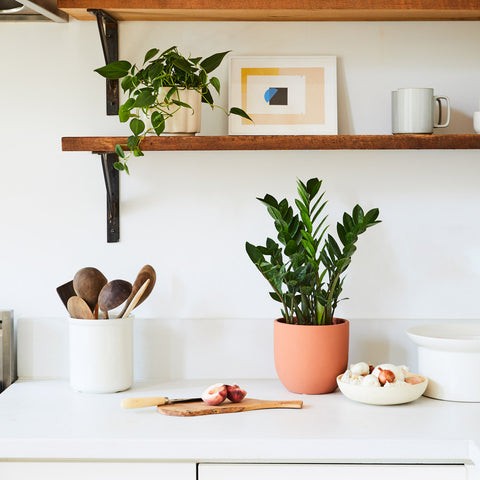The Zamioculcas zamiifolia, commonly known as the ZZ plant, has surged in popularity as a beloved houseplant, and for good reason. Native to Eastern Africa, this tropical perennial is celebrated for its resilience and adaptability to various indoor conditions. Its naturally glossy leaves, which transition from a vibrant lime green when young to a rich emerald green as they mature, add a touch of elegance to any space. Each leaflet typically measures between one to three inches in length, sprouting from robust, slightly bulbous stalks that emerge from substantial, water-storing rhizomes beneath the soil. If you’re looking for a dependable and low-maintenance houseplant, mastering Zz Plant Care is incredibly rewarding due to its tolerance for low light conditions and minimal watering needs.
 A vibrant ZZ plant with glossy green leaves in a modern pot, illuminated by natural indirect sunlight, showcasing its lush and healthy appearance.
A vibrant ZZ plant with glossy green leaves in a modern pot, illuminated by natural indirect sunlight, showcasing its lush and healthy appearance.
Optimal Sunlight for ZZ Plant Care
When it comes to sunlight, ZZ plants are quite forgiving, making zz plant care straightforward even in less than ideal lighting situations. They thrive best in medium to bright indirect light. While they are remarkably tolerant of lower indirect light conditions, it’s important to note that they are not suited for intense, direct sun exposure. Direct sunlight can scorch their leaves, so positioning them away from harsh, direct rays is key to maintaining their lush foliage.
Watering Your ZZ Plant: Finding the Perfect Balance
Watering is a crucial aspect of zz plant care, but thankfully, ZZ plants are drought-tolerant, simplifying this task. A good rule of thumb is to water your ZZ plant every 2 to 3 weeks. Allow the soil to dry out completely between waterings. It’s essential to adjust your watering frequency based on the light conditions; plants in brighter light will require more frequent watering, while those in lower light will need less. Overwatering is a more common issue than underwatering with ZZ plants, and it can lead to root rot, so it’s always better to err on the side of dryness.
Humidity and Temperature Needs for ZZ Plant Care
Maintaining the right humidity and temperature is generally not a concern with zz plant care, as ZZ plants are highly adaptable to typical household environments. Average home humidity levels are perfectly adequate for ZZ plants, and they can even tolerate dry air. Regarding temperature, ZZ plants flourish in the standard houseplant temperature range of 65°F-85°F (18°C-30°C). It’s advisable to avoid letting the temperature drop below 60°F (15°C), as this can stress the plant.
Choosing the Best Soil for Your ZZ Plant
Selecting the appropriate soil is vital for effective zz plant care. ZZ plants require a well-draining potting mix to prevent waterlogging and root rot. To enhance soil aeration, consider incorporating ingredients such as perlite or lava rocks into your potting mix. These amendments will improve drainage and create an optimal environment for the rhizomes to thrive. A well-aerated soil is crucial for healthy root development and overall plant vigor.
Common ZZ Plant Problems and Solutions
One of the appealing aspects of zz plant care is that ZZ plants are generally resilient and pest-free. However, like all houseplants, they can encounter a few common issues. Pests are infrequent, but if they do appear, treat them promptly with weekly applications of a natural pesticide such as neem oil and regularly wipe down the plant’s leaves.
Here are some common symptoms and their potential causes:
-
Symptom: Wilting plant with dry potting mix.
- Cause: The plant is thirsty and underwatered. Increase watering frequency, ensuring you still allow the soil to dry between waterings.
-
Symptom: Wrinkled leaves.
- Cause: Similar to wilting, wrinkled leaves indicate the plant is likely underwatered and needs more moisture.
-
Symptom: Yellowing leaves that become mushy, and wet potting mix.
- Cause: This is a sign of root rot, typically caused by overwatering. Reduce watering frequency and ensure proper drainage. In severe cases, you may need to repot the plant in fresh, dry potting mix after removing any rotten roots.
Precautions Regarding ZZ Plants
While ZZ plants are easy to care for, it’s important to be aware of certain precautions, especially if you have pets or small children. ZZ Plants can be irritating if their foliage is consumed by cats, dogs, or humans. As a general safety practice, it’s always best to keep houseplants out of reach of small children and pets to prevent accidental ingestion and potential irritation. Enjoying zz plant care responsibly ensures a safe and beautiful environment for everyone.
